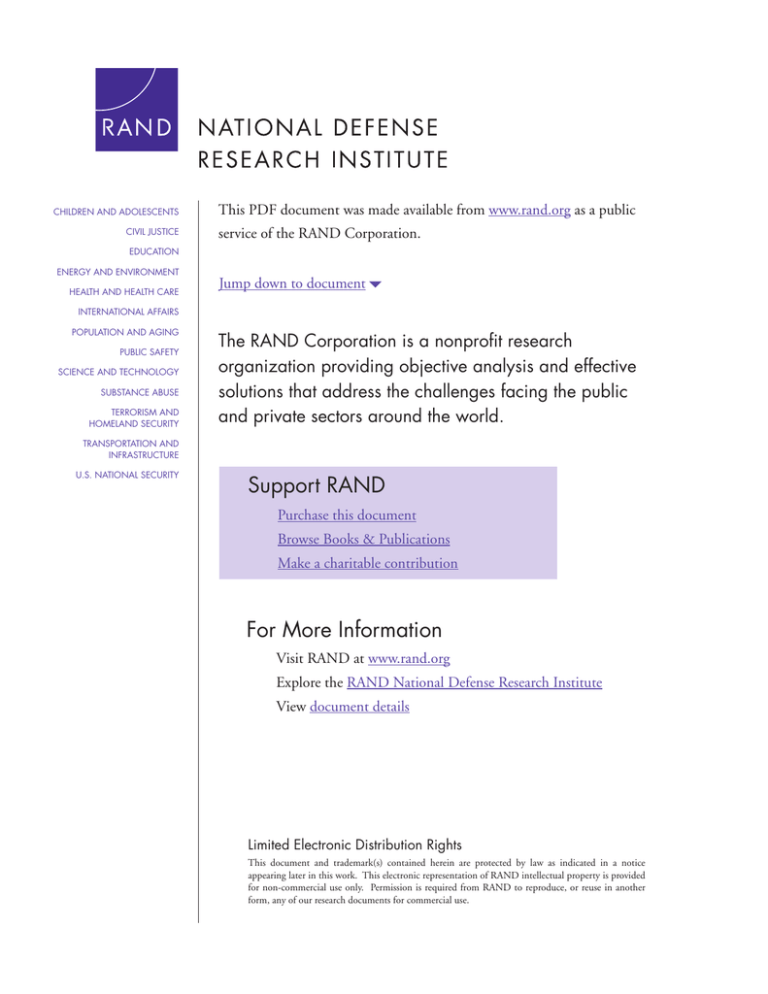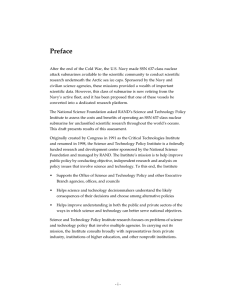
CHILDREN AND ADOLESCENTS
CIVIL JUSTICE
This PDF document was made available from www.rand.org as a public
service of the RAND Corporation.
EDUCATION
ENERGY AND ENVIRONMENT
HEALTH AND HEALTH CARE
Jump down to document6
INTERNATIONAL AFFAIRS
POPULATION AND AGING
PUBLIC SAFETY
SCIENCE AND TECHNOLOGY
SUBSTANCE ABUSE
TERRORISM AND
HOMELAND SECURITY
The RAND Corporation is a nonprofit research
organization providing objective analysis and effective
solutions that address the challenges facing the public
and private sectors around the world.
TRANSPORTATION AND
INFRASTRUCTURE
U.S. NATIONAL SECURITY
Support RAND
Purchase this document
Browse Books & Publications
Make a charitable contribution
For More Information
Visit RAND at www.rand.org
Explore the RAND National Defense Research Institute
View document details
Limited Electronic Distribution Rights
This document and trademark(s) contained herein are protected by law as indicated in a notice
appearing later in this work. This electronic representation of RAND intellectual property is provided
for non-commercial use only. Permission is required from RAND to reproduce, or reuse in another
form, any of our research documents for commercial use.
This product is part of the RAND Corporation documented briefing series. RAND
documented briefings are based on research briefed to a client, sponsor, or targeted audience and provide additional information on a specific topic. Although documented
briefings have been peer reviewed, they are not expected to be comprehensive and may
present preliminary findings.
Artificial Reefs
A Disposal Option for Navy and
MARAD Ships
MICHAEL V. HYNES, JOHN E. PETERS,
DENIS RUSHWORTH
DB-391-NAVY
March 2004
Prepared for the United States Navy
Approved for public release; distribution unlimited
The research described in this briefing was sponsored by the United States Navy. The
research was conducted in the RAND National Defense Research Institute, a federally
funded research and development center supported by the Office of the Secretary of
Defense, the Joint Staff, the unified commands, and the defense agencies under Contract
DASW01-01-C-0004.
ISBN 0-8330-3510-X
The RAND Corporation is a nonprofit research organization providing objective analysis
and effective solutions that address the challenges facing the public and private sectors
around the world. RAND’s publications do not necessarily reflect the opinions of its research
clients and sponsors.
R® is a registered trademark.
© Copyright 2004 RAND Corporation
All rights reserved. No part of this book may be reproduced in any form by any electronic or
mechanical means (including photocopying, recording, or information storage and retrieval)
without permission in writing from RAND.
Published 2004 by the RAND Corporation
1700 Main Street, P.O. Box 2138, Santa Monica, CA 90407-2138
1200 South Hayes Street, Arlington, VA 22202-5050
201 North Craig Street, Suite 202, Pittsburgh, PA 15213-1516
RAND URL: http://www.rand.org/
To order RAND documents or to obtain additional information, contact
Distribution Services: Telephone: (310) 451-7002;
Fax: (310) 451-6915; Email: order@rand.org
SUMMARY
By 2005, the U.S. Navy and the Maritime Administration (MARAD) will
have accumulated some 360 retired ships in need of disposal. These ships
include military ships of various types, plus commercial ships in the
Ready Reserve administered by MARAD. In previous decades, these ships
would have been recycled, or “scrapped,” by recycling yards in either the
United States or overseas, and the federal government would have
realized some monetary gain. U.S. shipyards can no longer economically
recycle ships, and concerns about environmental and safety conditions in
foreign recycling yards have led to suspension of that disposal option.
In a previous study (Hess et al., 2001), we assessed the recycling options,
along with two other ship-disposal options—keeping ships in storage
indefinitely and donating them for use as artificial reefs. We concluded
that reefing was the least-expensive feasible option. In fact, economic
activity associated with reefs could generate taxes at various levels of
government that together would be sufficient to offset federal costs.
Overseas recycling was also judged to be inexpensive, possibly even a nocost option, but U.S. Environmental Protection Agency (EPA) regulations
prohibit the export of items contaminated with polychlorinated biphenyls
(PCBs), a category into which military ships fit. Domestic recycling would
now have to be funded by the U.S. government, and long-term storage
would require regular protective measures and occasional dry-docking to
counteract the corrosive effects of salt water. Either approach would be
more expensive than reefing.
Having demonstrated the potential attractiveness of reefing as a disposal
option, we turned in the current study to an examination of economic,
legal, environmental, and programmatic issues that might bear on a
decision on whether and how to pursue the reefing option more seriously.
Our conclusions are as follows:
x
There is plenty of demand for ships for reefing, particularly along the
mid- and southern-Atlantic and Gulf coasts. There are at least 400 sites
ready to accept ships. The federal government may thus have the
luxury of choosing among applicants according to criteria such as a
match of funds at some level.
ix
x
Many elements of the institutional apparatus required to implement a
reefing program are in place. Most coastal states have artificial-reef
programs, and regional fishery commissions coordinate state interests.
MARAD has donated ships for reefing projects, some after transfer of
title from the Navy. Precedents may also be found in the National
Fisheries Enhancement Act of 1984, which permitted the conversion of
exhausted oil rigs to reefs, and in the Coast Guard’s routine practice of
retiring its ships for reef use. The Army Corps of Engineers has a
permitting process in place that ensures artificial reefs do not obstruct
navigation. The Federal Aid in Sport Fish Restoration Act of 1950
provides a potential source of funding for state or local reef-building
entities, which operate on very limited resources.
x
Environmental concerns have been raised, chiefly with respect to the
release of PCBs from sunken ships into the littoral environment. A
Navy testing program is allaying some of these fears, and a new EPA
process for approving unusual disposals is in place. There is, thus, a
basis for an EPA permitting process for reefing, and a further basis can
be found in standards established by Canada for that purpose. Other
environmental issues appear not to be as serious as the PCB issue.
x
Two further problems need to be addressed before a reefing program
can be pursued:
— The programs will need a business model. Will the Navy or
MARAD run the reefing program itself? Or will a separate
agency or federal corporation be established? Or will the Navy
or MARAD retain ownership while a contractor operates the
program? Or could both ownership and reefing be put out for
bid? These alternatives entail differing mixes of costs and risks
for the Navy, the resolution of which is beyond the scope of this
study. Whichever model is chosen, however, it would be most
attractive to reef-building entities if there were a single point of
contact within or under contract to the federal government.
Likewise, it would be most efficient for the contact if it had to
deal with only the states—that is, if each state decided which
proposals were most meritorious and put those forward under
its name.
— Certain laws would have to be amended. A provision against
spending federal money on reefing would probably have to be
repealed. Unless title of all ships to be reefed is to be transferred
x
to MARAD, the Navy will need clearer authority to donate
ships for reefing. It may also need broader authority to transfer
ships for reefing to another agency. Finally, of course,
authorization and appropriations acts will have to provide
funding, otherwise the program will go nowhere.
xi






